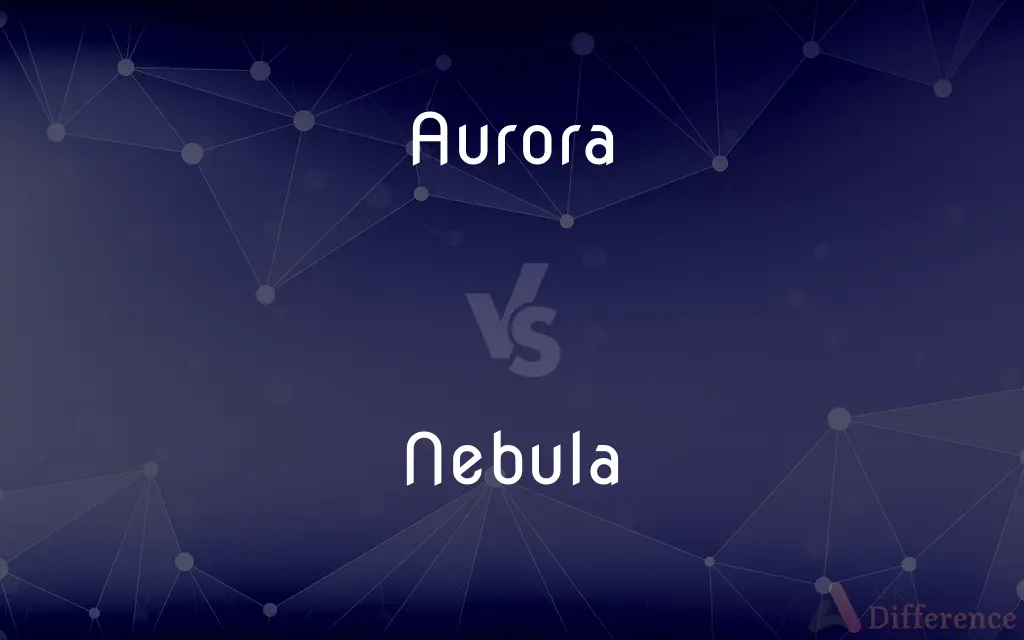Aurora vs. Nebula — What's the Difference?
By Urooj Arif & Fiza Rafique — Updated on February 28, 2024
Aurora is a natural light display in Earth's sky, primarily seen in high latitude regions, caused by solar winds disturbing the magnetosphere. Nebulae are vast clouds of gas and dust in space, often the birthplace of stars, visible as luminous patches.

Difference Between Aurora and Nebula
Table of Contents
ADVERTISEMENT
Key Differences
Auroras, known as the Northern or Southern Lights, are phenomena where the sky lights up with swirling patterns of colors, a result of charged particles from the sun colliding with the Earth's atmosphere. These displays are most common near the poles due to the Earth's magnetic field directing the particles toward the poles. Nebulae, on the other hand, are interstellar clouds located within galaxies, including our Milky Way. They consist of hydrogen gas, plasma, helium, and other ionized gases. Nebulae are often associated with star formation, as their gravitational pull can lead to the collapse of gas and dust, creating new stars.
The beauty of auroras is accessible to observers on Earth, especially in regions close to the magnetic poles, such as Canada, Norway, and Antarctica. Their visibility is influenced by solar activity and local weather conditions, making them a sought-after spectacle for tourists and photographers.
Nebulae, despite being far beyond our planet, contribute significantly to our understanding of the cosmos. They are studied through telescopes equipped with special filters and imaging techniques that can capture their complex structures and the processes within, revealing information about the lifecycle of stars.
Auroras are transient and can be observed from the Earth under specific conditions, nebulae are permanent fixtures in space, albeit changing over astronomical timescales. The study of nebulae requires advanced technology and scientific knowledge, whereas auroras can be enjoyed with the naked eye or minimal equipment.
Comparison Chart
Definition
A natural light display in the Earth's sky.
A cloud of gas and dust in outer space.
ADVERTISEMENT
Cause
Solar winds disturbing the Earth's magnetosphere.
Gravitational forces and star formation.
Location
High-latitude regions near the Earth's poles.
Interstellar space, within galaxies.
Visibility
With the naked eye from Earth.
Through telescopes, not visible to the naked eye.
Associated Phenomena
Magnetic storms, solar activity.
Star birth, supernovae remnants.
Colors
Green, red, purple, depending on the gas and altitude.
Various, depending on the gas and dust composition.
Observability
Dependent on solar activity and weather conditions.
Permanent but changes over astronomical timescales.
Interest
Touristic, photographic, scientific.
Astronomical, scientific.
Compare with Definitions
Aurora
A spectacular natural light show in the Earth's sky.
The aurora borealis lit up the Alaskan sky with green and purple hues.
Nebula
Often named for their shapes or the constellations they're found.
The Crab Nebula is the remnant of a supernova observed in 1054.
Aurora
Primarily observed near the poles.
Traveling to Iceland to see the aurora is on my bucket list.
Nebula
Visible through powerful telescopes.
Astronomers used the Hubble Telescope to capture stunning images of the nebula.
Aurora
A subject of myths and legends.
Ancient cultures had various myths explaining the aurora.
Nebula
Cosmic clouds of dust and gas where stars are born.
The Orion Nebula is a nursery for new stars.
Aurora
Dependent on geomagnetic activity.
The aurora is more intense during periods of high solar activity.
Nebula
Found throughout galaxies, including the Milky Way.
The Horsehead Nebula is a famous dark nebula in the Orion constellation.
Aurora
Visible effects of solar particles colliding with atmospheric gases.
We camped under the stars hoping to catch a glimpse of the aurora.
Nebula
Sites of complex chemical processes.
Nebulae play a crucial role in the chemical enrichment of the galaxy.
Aurora
An aurora (plural: auroras or aurorae), sometimes referred to as polar lights (aurora polaris), northern lights (aurora borealis), or southern lights (aurora australis), is a natural light display in the Earth's sky, predominantly seen in high-latitude regions (around the Arctic and Antarctic). Auroras are the result of disturbances in the magnetosphere caused by solar wind.
Nebula
A nebula (Latin for 'cloud' or 'fog'; pl. nebulae, nebulæ or nebulas) is an interstellar cloud of dust, hydrogen, helium and other ionized gases.
Aurora
The rising light of the morning; the dawn of day; the redness of the sky just before the sun rises.
Nebula
A cloud of gas and dust in outer space, visible in the night sky either as an indistinct bright patch or as a dark silhouette against other luminous matter.
Aurora
The rise, dawn, or beginning.
Nebula
A clouded spot on the cornea causing defective vision.
Aurora
The first light of day;
We got up before dawn
They talked until morning
Nebula
A diffuse cloud of interstellar dust or gas or both, visible as luminous patches or areas of darkness depending on the way the mass absorbs or reflects incident light or emits its own light.
Nebula
(astronomy) A cloud in outer space consisting of gas or dust (e.g. a cloud formed after a star explodes).
Common Curiosities
Are all nebulae visible to the naked eye?
No, most nebulae can only be seen with telescopes; a few, like the Orion Nebula, are barely visible to the naked eye in very dark skies.
What causes the different colors in auroras?
Colors depend on the type of gas molecules involved and their altitude; oxygen produces green and red, nitrogen produces blue and purple.
How far away are nebulae?
Nebulae can be anywhere from a few hundred to thousands of light-years away from Earth.
What is the best time to see an aurora?
The best time is during the equinox months of September and March when geomagnetic activity is higher, though winter's dark skies improve visibility.
Can auroras occur on other planets?
Yes, auroras have been observed on other solar system planets with magnetic fields, like Jupiter and Saturn.
Is it possible to predict when and where an aurora will appear?
Forecasts are possible based on solar activity, but local weather conditions also affect visibility.
How do scientists study nebulae?
Through observations with telescopes equipped with various filters and spectrographs, allowing them to analyze the light and identify chemicals.
What's the difference between an aurora and a meteor shower?
Auroras are caused by solar wind interacting with the atmosphere, while meteor showers result from Earth passing through debris from comets or asteroids.
Do nebulae move?
Nebulae are dynamic and can expand, evolve, and dissipate over millions of years.
Can nebulae be dangerous?
While nebulae are sites of intense radiation and energetic events, they pose no direct danger to Earth due to their vast distance from us.
Share Your Discovery

Previous Comparison
Warehouse vs. Stock
Next Comparison
Lignin vs. SuberinAuthor Spotlight
Written by
Urooj ArifUrooj is a skilled content writer at Ask Difference, known for her exceptional ability to simplify complex topics into engaging and informative content. With a passion for research and a flair for clear, concise writing, she consistently delivers articles that resonate with our diverse audience.
Co-written by
Fiza RafiqueFiza Rafique is a skilled content writer at AskDifference.com, where she meticulously refines and enhances written pieces. Drawing from her vast editorial expertise, Fiza ensures clarity, accuracy, and precision in every article. Passionate about language, she continually seeks to elevate the quality of content for readers worldwide.














































